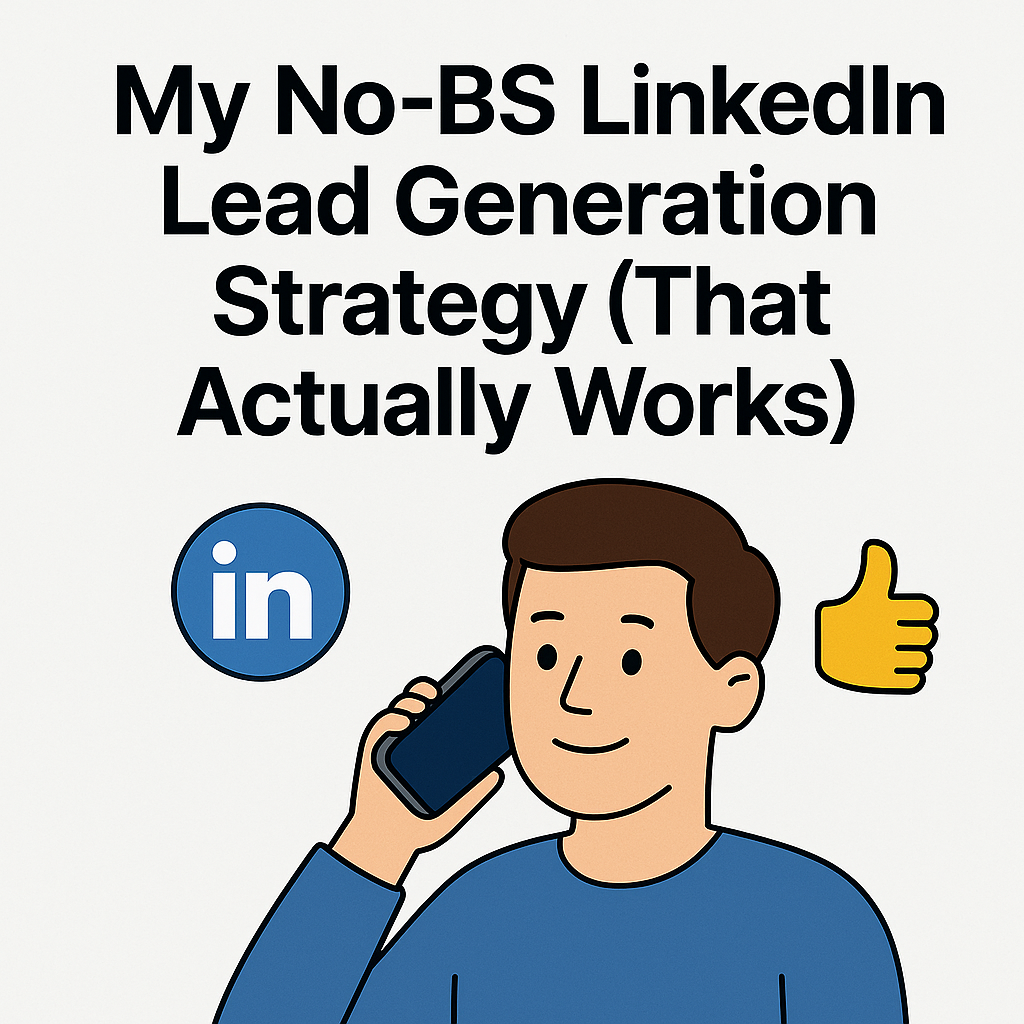My Brutally Honest Guide to B2B Lead Generation on LinkedIn
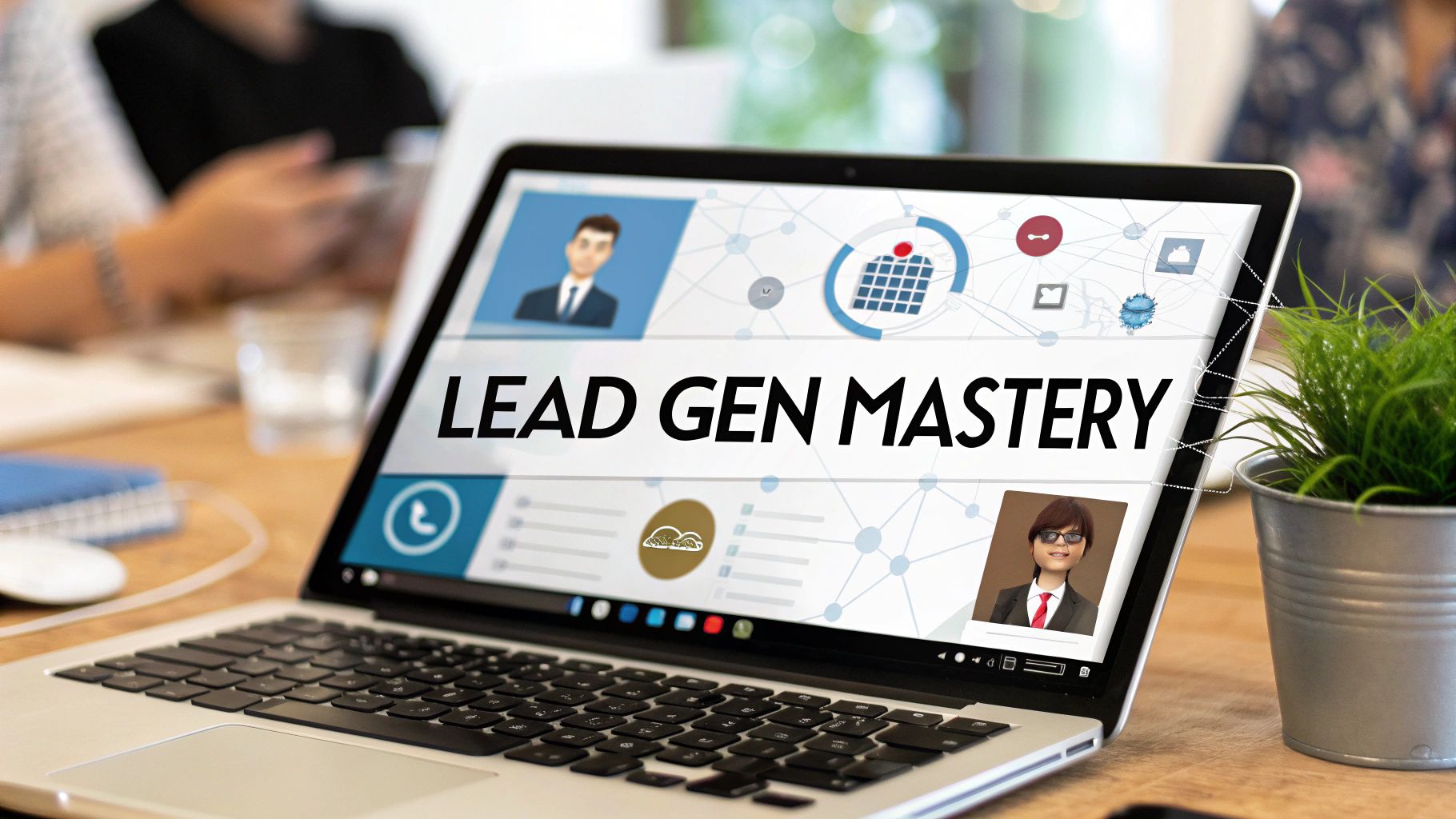
Let's be honest for a moment. When it comes to B2B lead generation on LinkedIn, one simple idea is key: people buy from those they know, like, and trust. Your success isn't about sending out a hundred connection requests daily. It’s about transforming your profile from an outdated digital resume into a genuine magnet for high-value prospects...the kind that sparks real conversations.
I've been in the trenches, I've made the mistakes, and I'm here to give you the playbook that works. Ready to get started? Let's go.
Why Your LinkedIn Profile Is Pushing Leads Away
Let’s have a frank chat. Is your LinkedIn profile a dusty, forgotten resume or a lead-generating machine working for you 24/7? For years, mine was the first one, and I honestly cringe thinking about all the opportunities I must have missed. It was the classic, "I'm a [Job Title] at [Company]" snoozefest. It didn't solve anyone's problems or make any curious. It just… sat there.
The hard truth is that a generic or half-finished profile is actively repelling the exact people you want to attract. Before a prospect even clicks on your message, they've already made a snap judgment based on your profile. What impression are you giving off right now?
Your Headline Is Your First Impression
Your headline is the most valuable piece of real estate on your entire profile. Most people put their job title in and call it a day, which is a huge missed opportunity. A great headline doesn't just say what you are; it tells people what you do for them.
- NEVER Do This: "Sales Manager at Tech Solutions Inc." (This tells me nothing about how you can help me.)
- Do This Instead: "I Help B2B SaaS Founders Build a Predictable Sales Pipeline Without Wasting Money on Ads" (Now I instantly know your value and exactly who you help.)
This one tweak completely changes the dynamic. You go from being just another salesperson to a potential problem-solver, which makes prospects far more likely to accept your connection request.
Your "About" Section Needs to Tell a Story
Think of your "About" section as your personal sales page, not your life story. I used to make the mistake of just listing my career history and a few accomplishments. The reality? Nobody cared. It wasn't until I rewrote it to tell a story, one that focused on my ideal client's biggest headaches, that things started to change.
Your LinkedIn "About" section should feel like a conversation. It needs to show you understand your prospect's challenges, prove your expertise through a relatable story, and then clearly guide them on what to do next. It's not about you; it's all about them.
Here's a simple, step-by-step tutorial to make it happen:
- The Hook: Kick things off with a sentence that hits on a major pain point your audience is feeling.
- Empathy & Authority: Briefly show them you understand their struggle and have the experience to fix it. This is where a quick personal anecdote works wonders.
- The Proof: Drop in a key result or a quick success story to build credibility.
- The Call-to-Action (CTA): Be direct. Tell them exactly what the next step is. "DM me for a free audit," "Book a call here," or "Check out my case study below."
Following this framework turns a boring bio into a compelling story that builds trust almost instantly. Remember, a great profile does a lot of the heavy lifting for you, warming up leads before you even send the first message. You can use powerful tools like GojiberryAI to find the right people, but a weak profile will sabotage your efforts before you even get started.
Finding High-Value Leads Without Wasting Hours
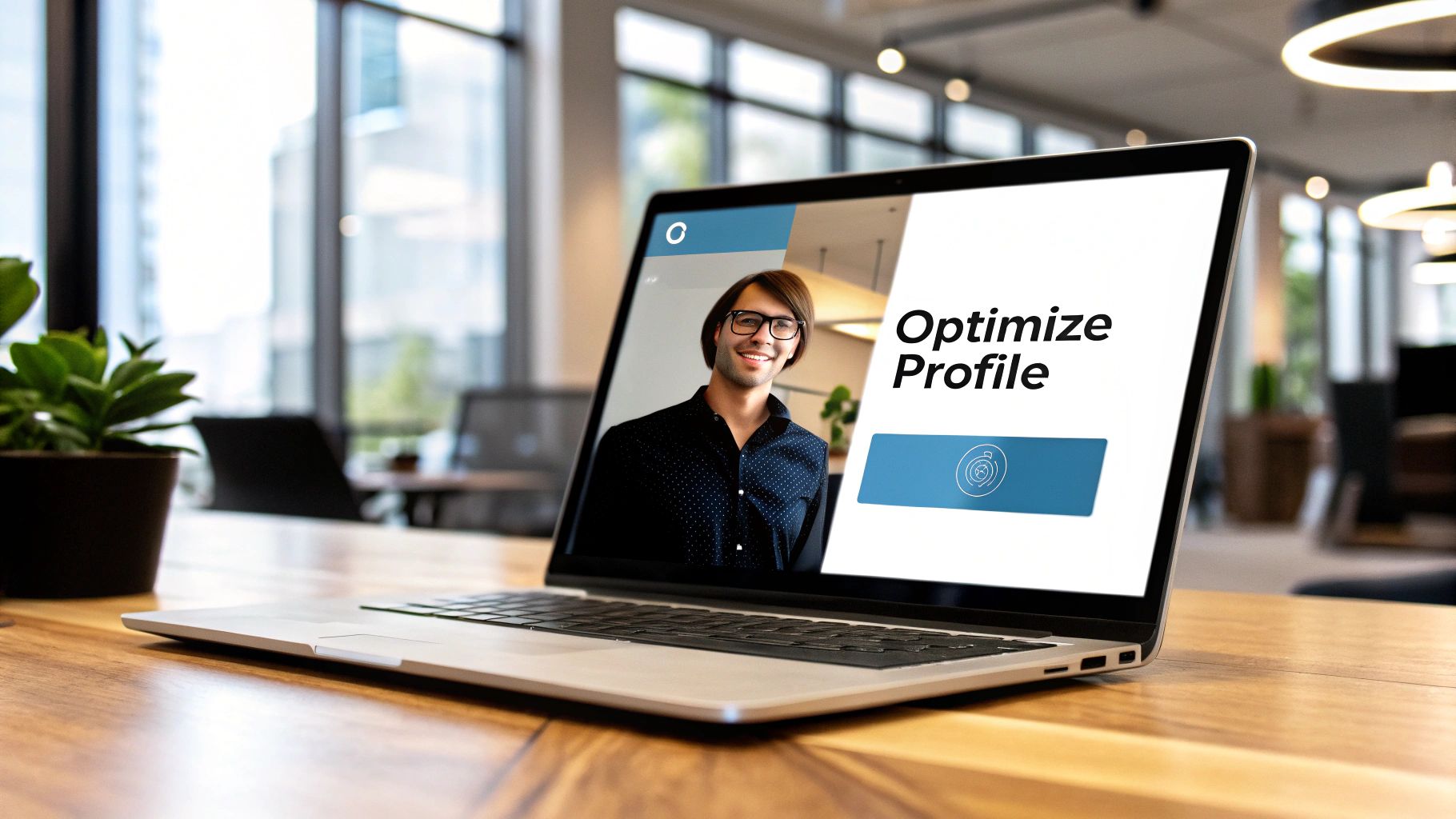
Let's address a major mistake I see people make all the time: endlessly scrolling the LinkedIn feed and calling it "prospecting." Sound familiar? It feels productive, but it's a time-suck that gets you nowhere. I learned the hard way that a huge network of irrelevant connections is completely worthless for B2B lead generation.
The real power is in targeted searching, but most people barely scratch the surface of what LinkedIn can do. It's no surprise that 80% of all B2B leads from social media come directly from LinkedIn; the platform is designed for this, but only if you know how to utilize its tools effectively.
Go Way Beyond Basic Job Title Searches
Just filtering by job title? That's child's play. If you want to find genuinely high-value prospects, you need to think more like a detective. We're going to get into the nitty-gritty of building a hyper-targeted list because a list of 50 ideal prospects is infinitely more valuable than 500 random ones.
This is where Boolean search becomes your secret weapon. It may sound technical, but it’s pretty simple. It means using operators like AND, OR, and NOT to narrow your search results.
- Want to find marketing leaders but filter out assistants? Try this: "Marketing" AND ("Director" OR "VP") NOT "Assistant"
- That one simple string cuts through the noise and zeroes in on the actual decision-makers.
The goal isn't just to find people with the right title. It's about finding people with the right title who are actively signaling they might need what you're selling. That’s the core of smart B2B lead generation on LinkedIn.
How To Spot Critical Buying Signals
Okay, so you've refined your search. Now what? The next step is to look for buying signals. These are the digital breadcrumbs people leave that show they're in a problem-solving mode and ready to talk.
Here’s what I always look for:
- Recent Activity: Filter your search by "Past week" to find people who are actively posting, commenting, or engaging. An active user is far more likely to see and respond to your message.
- Keyword Searches in Posts: Use the "Content" search filter to find people talking about specific pain points. Search for phrases like "recommend CRM" or "struggling with sales outreach." This is gold.
- Competitor Engagement: Take a look at who's commenting on your competitor’s content. These are warm leads already exploring solutions in your space.
Yes, these tactics take more effort than a lazy search, but the payoff is huge. You’re not just getting leads; you're finding people at the exact moment they’re most open to hearing from you.
By combining sharp Boolean searches with a keen eye for buying signals, you stop wasting hours and start building a pipeline of prospects who want to talk. When you're ready, pairing these methods with some of the top free LinkedIn lead generation tools can put this entire process on steroids without costing a dime.
Crafting Messages That Get Replies
Can we all agree to ban the default, soul-crushing “I’d like to add you to my professional network” request forever? It's lazy, ineffective, and shows you've put zero thought into connecting. But what’s even worse? That immediate, aggressive sales pitch that lands in your inbox the second after you accept.
I’ve made this mistake myself. Early in my career, I treated LinkedIn messaging like a numbers game, blasting out generic templates and hoping something stuck. The result was a shockingly low acceptance rate and a whole lot of wasted time.
The real secret to effective B2B lead generation on LinkedIn isn’t about volume; it's about making your outreach feel genuinely human.
The "Give Before You Ask" Framework
The most powerful principle I ever learned for LinkedIn outreach is the ‘Give Before You Ask’ framework. It’s simple: provide value before you ever ask for anything in return, whether it's a meeting, a demo, or their email address. This completely flips the script from "What can you do for me?" to "How can I help you?"
This could be as simple as:
- Leaving a thoughtful comment on their recent post.
- Sending them a link to an article you think they'd find genuinely useful.
- Introducing them to someone in your network who could be a valuable connection.
When you lead with generosity, you build rapport and trust. You stop being just another salesperson and start becoming a valued contact. People are dramatically more likely to respond to someone who has already given them something for free.
The data clearly shows that taking a moment to personalize your invite can nearly triple the acceptance rate. That's a massive win for your lead generation efforts.
A Practical Guide to Non-Spammy Messaging
Ready to put this into practice? Here’s a simple, non-cringeworthy approach you can follow. It starts with your connection request and continues long after they accept.
To make this crystal clear, let's see what separates a great outreach message from a terrible one.
Outreach Approach Comparison: Do This vs NEVER Do This
The difference is night and day. One approach builds relationships; the other burns bridges.
Once you've made that initial connection, the goal isn't to pounce, but to nurture. And if they reply to your opening question, great! Have a normal conversation. If not, wait about a week and follow up with more value, such as a relevant article or resource.
And if you want to dive deeper, you can also explore how to master the art of B2B social selling and turn your social media into a sales machine. This approach goes beyond simple messaging and helps you build a holistic strategy for generating revenue through social platforms.
Creating Content That Establishes Your Authority

Let's kill a myth right now: content for B2B lead generation on LinkedIn is not about going viral. It’s about systematically building trust so your ideal clients come to you. For the longest time, I made a huge misstep; I thought my day-to-day experiences and solutions were too boring to share. Who would care?
The answer? Your future customers. Your unique perspective, your stories, and your solutions are exactly what they need to hear to see you as an authority. Stop selling, and start teaching.
The Four Pillars of High-Value Content
Your content needs a job to do. To attract and warm up prospects, every post should fit into one of these four pillars. Think of this as your simplified weekly content plan.
- Pillar 1 - Address Pain Points: What keeps your ideal client up at night? Create content that addresses their biggest frustrations. This shows empathy and positions you as a problem-solver.
- Pillar 2 - Share Success Stories (Yours or Others'): Case studies and client wins are fantastic. But you can also share a story about how you solved a problem for yourself. This builds massive credibility.
- Pillar 3 - Debunk Industry Myths: Every industry has common misconceptions. Challenge one. This establishes you as a thought leader who isn't afraid to express your view.
- Pillar 4 - Offer Personal Insights: Share a lesson you learned, a mistake you made, or a productivity hack you discovered. This humanizes you and makes you relatable.
Your goal with content is to become so consistently valuable that when a prospect has a problem you can solve, your name is the first one that comes to mind. That is the essence of effective inbound lead generation on LinkedIn.
The data backs this up. It's fascinating that 40% of LinkedIn visitors engage organically with a business page each week, showing a massive appetite for valuable content without any ad spend. You can find more details on this organic engagement in this Sopro.io report.
A Simple Framework for a Week of Content
So, how do you put this into action without spending all day writing? Here's a tutorial.
- Monday (Pain Point): Write a text-only post about a major challenge in your industry. Keep it short and ask a question to spark a conversation. Example: "Struggling to get sales and marketing to agree on lead quality? Here’s the one question that ends the debate..."
- Wednesday (Success Story): Create a simple carousel (3-5 slides) detailing a recent client win. Focus on the before, the after, and the key takeaway. Visuals grab attention in the feed.
- Friday (Personal Insight): Share a personal story or a lesson learned. This is perfect for building connections heading into the weekend.
That’s it. Three high-value posts a week, each with a specific job. You'll build authority, warm up your audience, and attract inbound leads. To accelerate your content creation, you might be interested in our guide to the viral LinkedIn post generator, which can help you brainstorm compelling ideas. This consistent approach is your engine for successful B2B lead generation on LinkedIn.
A Smart Approach to LinkedIn Ads
Organic strategies are powerful, but let’s be real, sometimes you need to pour a little gasoline on the fire. When you need to accelerate results, LinkedIn Ads can be an absolute goldmine for B2B lead generation. I’ve got to warn you, though: without a smart approach, they can also be a brutal money pit.
Trust me, I’ve made the expensive mistakes, so you don't have to.
The key is to forget about randomly boosting posts. The single most effective tool in the LinkedIn Ads arsenal, especially for B2B, is the Lead Gen Form. Why? It's all about removing friction. Your prospect sees your ad, clicks, and their information, like their name, email, and company, is pre-filled directly from their profile. All they have to do is hit "Submit." They never even have to leave the LinkedIn platform. It's brilliant.
The Only Ad Type You Need to Start
I used to get lost in the sea of ad formats, Sponsored Content, Message Ads, and Dynamic Ads. It felt overwhelming. Then I focused exclusively on Lead Gen Forms, and everything changed. My cost per lead reduced, and the quality of my conversions soared.
The stats back this up. While typical LinkedIn ad conversion rates often hover around 6-7%, Lead Gen Forms can see submission rates of 10% to 15%. That's a massive difference. Marketers consistently trust LinkedIn's ROI over other platforms because of its precise targeting, and these forms are a perfect example of that power in action. You can discover more insights about LinkedIn ad performance on thunderbit.com.
My Simplified Campaign Tutorial
Ready to set one up without pulling your hair out? Here’s my guide to running your first campaign effectively.
Define Your Audience (The Right Way)
This is the most critical step. Get it wrong, and nothing else matters.
- NEVER target a broad audience such as "Marketing Managers in the United States." It's a recipe for burning cash.
- DO THIS INSTEAD: Upload the hyper-targeted prospect list we built earlier as a Matched Audience. This is your secret weapon. You're showing your ad only to the exact decision-makers you've already identified.
Set a Realistic Budget
You don't need thousands to start. I always recommend a test budget of $20-$30 per day for about a week. This generates enough meaningful data without outrageous spending.
Keep a close eye on your Cost Per Lead (CPL). If it's looking way too high after three days, don't be afraid to pause the campaign. It's a sign you need to re-evaluate your ad copy or the offer itself.
Write Ad Copy That Converts
Your ad needs to stop the scroll and speak directly to your ideal customer.
- Headline: Call out your audience and their biggest pain point. Something like, "SaaS Founders: Tired of Inconsistent Lead Flow?" works wonders because it immediately qualifies who should pay attention.
- Offer: Make it irresistible. A generic "Contact Us" won't cut it. You need to offer a high-value asset. Think about a detailed case study, a free assessment tool, or an exclusive industry report they can't get anywhere else.
This focused approach completely demystifies LinkedIn Ads. By using the prospect lists you’ve already built and pairing them with a high-converting Lead Gen Form, you create a hyper-efficient system for B2B lead generation. This isn't just about spending money on ads; it’s about making a strategic investment to get in front of the right people, right now.
Your Daily B2B LinkedIn Lead Generation Playbook
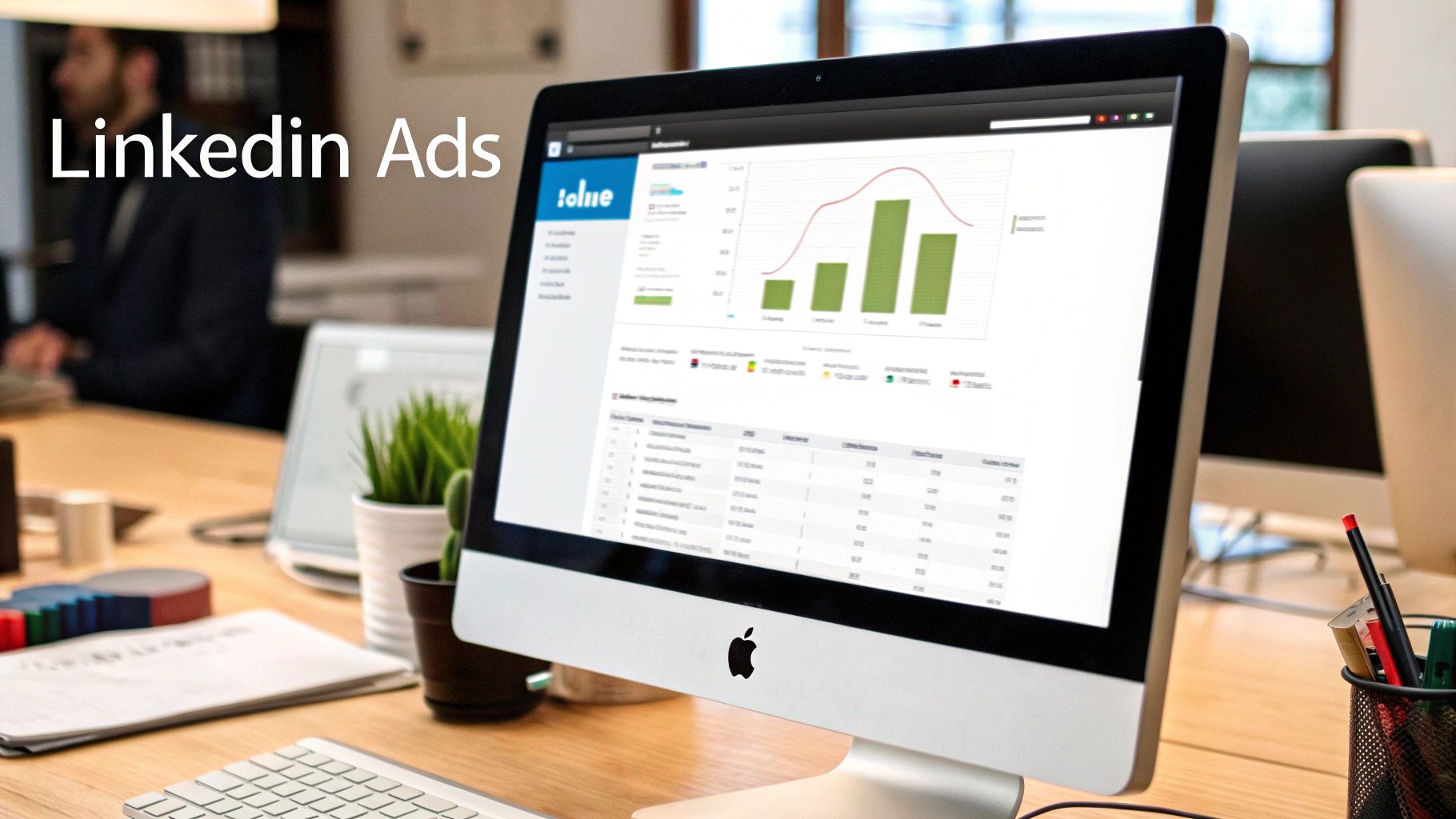
Alright, we’ve covered a lot of ground, from optimizing your profile to creating content that doesn't suck and even running some smart ads. But let's be honest, a strategy is just a nice idea until you do something with it.
So, how do you weave all this into a routine that generates leads without you having to live on LinkedIn 24/7?
This is where it all comes together. I’m going to walk you through the exact daily and weekly system I've used for years to keep my B2B pipeline full. And the best part? It takes less than 30 minutes a day. Seriously. When it comes to LinkedIn, consistency pays off. Forget spending hours aimlessly scrolling; this is all about focused, high-impact action.
The 30-Minute Daily Workflow
Here’s how you can break down your daily LinkedIn activity into manageable, 10-minute sprints. This structure is my secret to staying on track and focusing only on what matters.
- First 10 Minutes: Targeted Connections
This is your outreach block. Send out 3-5 highly personalized connection requests. You'll pull these names directly from the targeted lists we built earlier. Your connection note must reference something specific, a shared connection, a post they recently wrote, or their company's latest funding round. The goal here isn't volume; it’s making every single request feel like it was meant only for them.
- Next 10 Minutes: Nurture and Engage
Time to build some relationships. First, tackle your inbox and reply to any waiting messages. Then, jump over to your feed and leave 2-3 thoughtful comments on posts from your key prospects or current clients. A comment that adds value or asks a smart question is a thousand times more effective than a generic "Great post!"
- Final 10 Minutes: Share Your Expertise
Now, it's your turn to post. Share one piece of content or a valuable insight. It doesn't need to be a viral masterpiece every day. A simple text post about a lesson you learned this week or sharing a great article with your take on it works perfectly. The key is consistent visibility.
Your Essential Dos and Don'ts Checklist
Let’s boil it all down. To make your efforts on LinkedIn genuinely pay off, there are some non-negotiables. I learned these the hard way, through plenty of trial and error (and some truly cringeworthy early mistakes).
What To Do
- Do follow the 80/20 rule: spend 80% of your time engaging with others and only 20% posting your own content.
- Do personalize every single connection request and follow-up message. No exceptions.
- Do keep track of your conversations and know when it’s time to move the discussion to a call or email.
- Do use a tool like GojiberryAI to spot buying signals so you can prioritize who to talk to first.
What to NEVER, Ever Do
- NEVER send a sales pitch in your first message. It’s the fastest way to get ignored or, worse, removed as a connection.
- NEVER use the lazy, default "I'd like to connect" invitation.
- NEVER add someone just to immediately export them to your email list. It’s spammy and damages your reputation.
- NEVER neglect your profile. It’s your digital salesperson, working for you around the clock.
This guide gives you the exact blueprint for turning LinkedIn into a reliable source of high-quality B2B leads. We've gone from a dead profile to a lead-generating magnet, from lazy searching to surgical prospecting, and from spammy outreach to building genuine relationships.
The real magic isn't in knowing what to do; it's in consistently doing it. This simple, repeatable plan is your key to finding your next client, building trust, and turning conversations into revenue. Now, it's your turn. Your next client is on LinkedIn right now, waiting for a genuine person to connect with. Let's get to it.
Frequently Asked Questions
Let's tackle some of the common questions I get about using LinkedIn for B2B lead generation. These are the things I wish someone had told me when I was first starting, based on years of trial and error.
How Much Time Should I Be Spending on LinkedIn Every Day?
Honestly, forget the idea of spending hours glued to your screen. The key isn't intensity; it's consistency. A focused 20-30 minutes a day will do more for you than a frantic, multi-hour session once a week. I learned that the hard way after burning out trying to do everything at once.
Here’s a simple routine I've found incredibly effective:
- 10 minutes: Send out 3-5 genuinely personalized connection requests. No templates.
- 10 minutes: Dive into your network. Leave thoughtful comments on posts and reply to messages in your inbox.
- 5 minutes: Share one valuable thought, idea, or comment of your own.
This small daily habit creates momentum and delivers real results without completely hijacking your schedule. It’s all about making smart, targeted moves, not just being "busy."
Is LinkedIn Sales Navigator Actually Worth the Money?
This is a great question, and my answer is usually, "It depends on where you're at." If you're starting, I strongly recommend mastering the free version's search features first. You can get surprisingly far with clever Boolean searches and filters; that’s how I built my initial pipeline.
When your LinkedIn activity starts bringing in actual revenue and you feel like you're hitting a wall with the free search, Sales Navigator becomes an absolute must. Its advanced filtering, saved lead lists, and extra InMail credits are what allow you to scale your efforts.
My rule of thumb: Only upgrade to Sales Navigator when you can clearly map out how it will pay for itself. Don't get it just to have it; get it to amplify what's already working.
What Are the Biggest Red Flags to Look Out for When Connecting?
Your time is your most precious resource on LinkedIn. I learned to guard it fiercely by spotting the time-wasters from a mile away. Here are the major red flags that should make you think twice:
- The Instant Pitch: You accept their connection, and bam...a sales pitch hits your inbox.
- The Generic Invite: The classic connection request with zero personalization. It's a clear sign you're just a number to them.
- The Ghost Profile: A sparse profile, looks unprofessional, or has no recent activity. It’s often not worth the risk.
- The Premature Ask: Someone asking for your email or a spot on your calendar before a single genuine word has been exchanged.
Always remember: one high-quality connection is worth a hundred spammy ones.
Ready to stop guessing and start getting warm leads from prospects showing real buying intent on LinkedIn? GojiberryAI gets prospects who are actively engaging with your competitors or posting about problems you can solve, and delivers them right to your inbox.
Discover how GojiberryAI can fill your pipeline with high-intent B2B leads.
More High-Intent Leads = Your New Growth Engine.
Start Now and Get New High Intent Leads DeliveredStraight to Slack or Your Inbox.







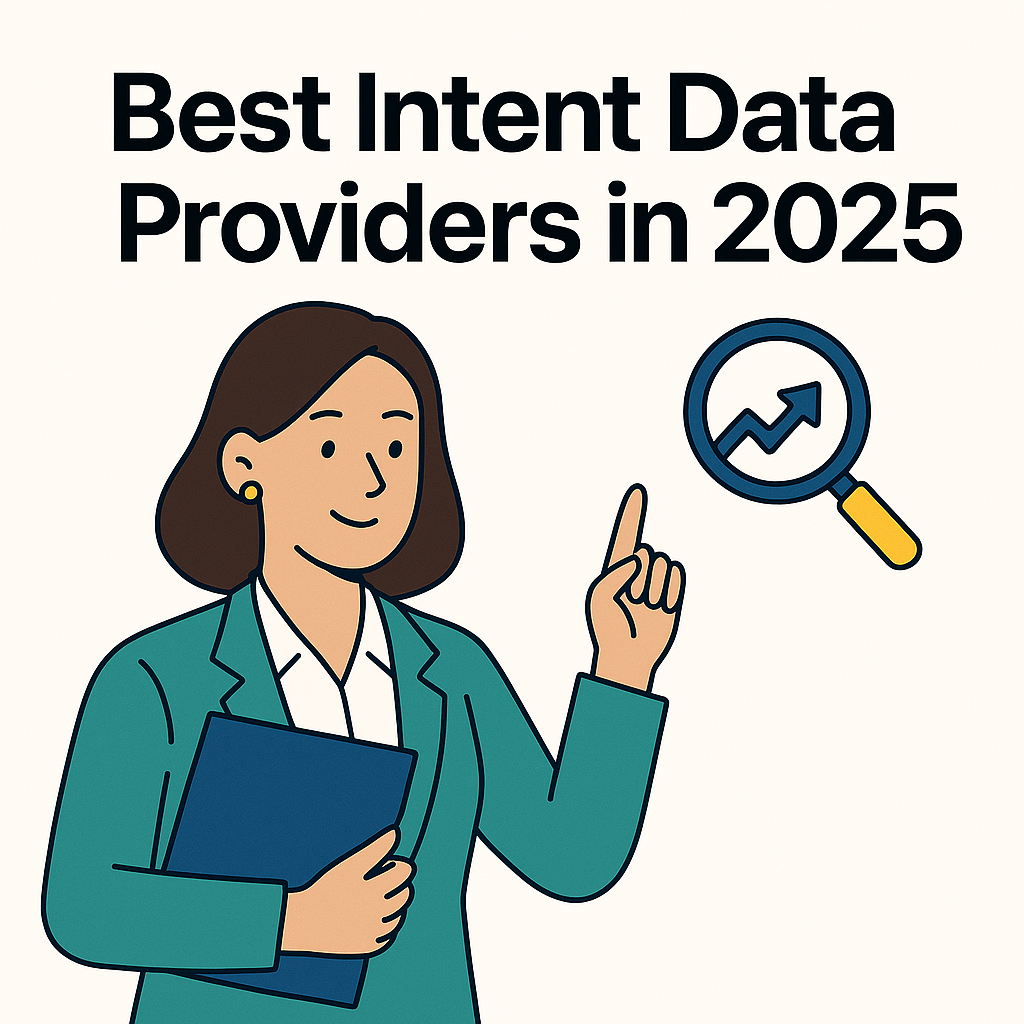

.png)
